Von Alexander Uhlmann
Ho Chi Minh City, Vietnam’s thriving business centre, is definitely on a fast-forward mode. It developed from a small fishing village to a busy colonial trade spot to a not-to-be-ignored megacity packed with French colonial buildings right next to neck breaking sky scrapers. Especially since the economic opening of Doi moi the city is bursting with energy. Economic and city development is at speed and there is no end in view. Geozentrale’s first article in English tells the story of this city over the last 300 years with a focus on colonial and post-colonial times, and the ambitious projects the city is facing.
Pre-colonial time
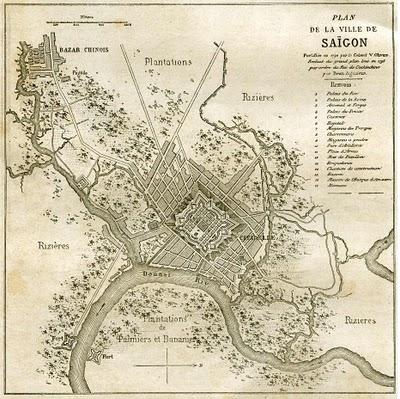 The first settlements in the area of today’s old town of Saigon date back to Khmer times from 1st to 6th century. It was rather a loose gathering of buildings than a town structured settlement. It was a fishing village as well as a trade centre with ties to China, India and Malaya which made foreign traders settle in the area. The port played an important role and is still the city’s nucleus.
The first settlements in the area of today’s old town of Saigon date back to Khmer times from 1st to 6th century. It was rather a loose gathering of buildings than a town structured settlement. It was a fishing village as well as a trade centre with ties to China, India and Malaya which made foreign traders settle in the area. The port played an important role and is still the city’s nucleus.
In 1698 the area was captured by Viet people and mentioned in a document for the first time. Until colonial times a kind of threefold town developed: the port and administration town Saigon; Gia Dinh (Già Ðinh) as citadel and garrison town a few kilometres to the north-west of Saigon; and the Chinese trade spot Cholon (Chợ Lơn – Big Market) to the south-west (confer map left). The Chinese people of Cholon maintained strong trade relations to their mother country and used Saigon’s port as a basis. Additionally they were able to use its well developed administration structures. Saigon, however, could benefit from the Chinese’s trade ties which lead to a symbiotic relationship between both towns.
French colonial time (1864 – 1940)
Despite the early settling of the area there are hardly any buildings from pre-colonial times since the settlement that had existed until the arrival of the French stayed rather small and consisted merely of a couple of wooden huts at the western banks of the Saigon River. That changed enormously after 1861 when the French captured Saigon. This should be seen in the context of the colonial race with England, which had already seized two towns in the region, Singapore and Hong Kong. Shortly after the capture of Saigon the French started to transform the town into the administrative centre of Cochin China (the southern part of Vietnam). The development followed the building plans of 1862 and 1865 that intended to expand the town to 2,500 hectares and raise the number of inhabitants to 500,000. At that time there were only 50,000 Vietnamese and Chinese living in the area, plus about 600 Europeans.
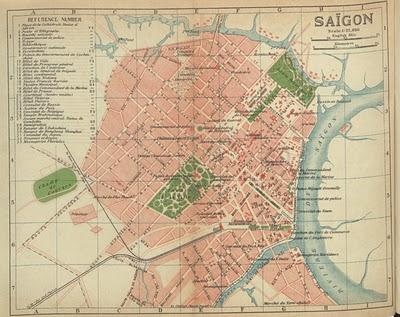 The development of Saigon is very similar to most south-east Asian commercial centres that have been expanded in colonial times, are mostly sea ports and arouse from trade functions. Thus the town was drawn up in a regular rectangular grid-like pattern with city blocks modelled on Paris; boulevards and avenues as main axis running from north-west to south-west respectively at right angles. The port depicted the core of the grid (confer map left). With this alignment the region’s main wind directions were acknowledged venting the town automatically. In addition the reference to Cholon and the port were established. Rue Catinat, today’s Ðường Ðóng Khởi, being the main axis from the port to the cathedral was designed as the main shopping street. Prestigious buildings such as the opera, Notre Dame Cathedral and the town hall erected in or close to Rue Catinat. Along with the Botanical Gardens they were all build until the end of the 19th century under French colonial reign.
The development of Saigon is very similar to most south-east Asian commercial centres that have been expanded in colonial times, are mostly sea ports and arouse from trade functions. Thus the town was drawn up in a regular rectangular grid-like pattern with city blocks modelled on Paris; boulevards and avenues as main axis running from north-west to south-west respectively at right angles. The port depicted the core of the grid (confer map left). With this alignment the region’s main wind directions were acknowledged venting the town automatically. In addition the reference to Cholon and the port were established. Rue Catinat, today’s Ðường Ðóng Khởi, being the main axis from the port to the cathedral was designed as the main shopping street. Prestigious buildings such as the opera, Notre Dame Cathedral and the town hall erected in or close to Rue Catinat. Along with the Botanical Gardens they were all build until the end of the 19th century under French colonial reign.
The urban planning model of the French was the idea of a “Ville Parc”, which more than 20,000 trees were planted for (confer picture below). Due to its beauty Saigon was often referred to as “Perle de l’Extrême Orient”, it had developed from small market town to the thriving colonial metropolis of Indochina. The French colonial administration also built up a transport infrastructure in the form of tramways and railways. The train link from Saigon’s centre to Cholon does not exist anymore, neither does the French built main station; it was shifted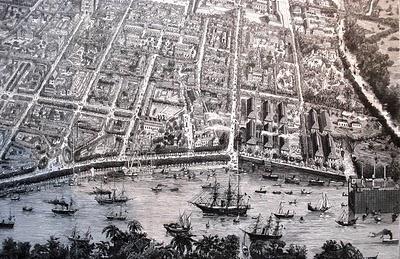 further north and replaced by a park. The road layout in District 1 however has not changed since then and still meets the original sketches from the colonial time.
further north and replaced by a park. The road layout in District 1 however has not changed since then and still meets the original sketches from the colonial time.
The picture shows the large amount of trees, the city blocks and grid-like pattern with wide tree-lined avenues. Notre Dame Cathedral is on the upper left rim with Rue Catinat leading towards it from the river.
After 1940
During World War II many people fled from the surrounding villages into the supposedly safer city which made the already existing housing shortage even worse. After the end of the war the biggest part of the infrastructure was destroyed. Many people returned to their villages and Saigon’s population decreased but the housing shortage persisted. Until 1965 the municipal area was filled up, especially between Saigon and Cholon and the main roads running from east to west; consistently both towns were united in 1956 and henceforth called Saigon-Cholon. During that period of US-American control there were no town planning initiatives but the Americans invested in administration, schools and universities, which led to a population increase; until 1967 it rose to 1.75 million. One of the few buildings erected in that period is the Reunification Palace (below) that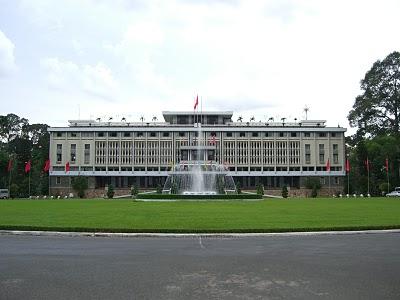 substituted the French-built Presidential Palace. During the civil war Saigon, again, was a place of refuge for many rural dwellers and grew radial along the arterial roads, mostly to the north for rivers formed natural barriers to the east and south. Additionally the city’s centre got even more filled up. Due to a lack of housing squatter settlements emerged. On April 30th 1975, the day of “the fall” respectively “the liberation” of Saigon the population amounted to 2.5 million.
substituted the French-built Presidential Palace. During the civil war Saigon, again, was a place of refuge for many rural dwellers and grew radial along the arterial roads, mostly to the north for rivers formed natural barriers to the east and south. Additionally the city’s centre got even more filled up. Due to a lack of housing squatter settlements emerged. On April 30th 1975, the day of “the fall” respectively “the liberation” of Saigon the population amounted to 2.5 million.
1975 – 1986
What followed was a process of de-urbanisation for the communist regime had decided to shrink large urban centres. It was necessary to obtain permits for housing and many dwellers were dislocated, refugees were to return to their places of origin, the urban growth slowed down and more or less stopped. From 1976 to 1980 400,000 people were to leave the city. That stark loss of population was partly compensated by the incorporation of Gia Dinh, but from 1979 to 1989 the annual population growth amounted to mere 0.3%. In 1976 Saigon was officially renamed Ho Chi Minh City which is often seen as a humiliation: the communists in power in the capital Hanoi considered Saigon as the “whore of America” and by far too liberal and capitalistic. The town, having always been the commercial centre of the country, was taken its industry, its population and all investments, in what section so ever, additionally all town planning measures were cancelled.
Economic opening “Doi moi” since 1986
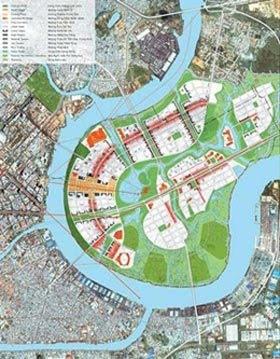 It wasn’t until “Doi moi” (Đổi mới) that this situation changed. A new housing policy was started and the secondary centres were upgraded which led to a strong influx to those. Since then the population grows steadily, especially due to stark rural-urban moves; from 1989 to 1999 by 2.7% annually, in 2007 by even 3.5%. At present the city’s development follows the model of a decentralised concentration which includes the satellite towns of Bien Hoa and Dau Mot, some 50 km away, infrastructure projects concerning several communes, new industry and high tech parks such as thriving Quang Trung Software City, the upgrade of the airport to an international hub and new town development projects in urban and suburban areas, such as Saigon South, which is supposed to provide housing and business space for 1 million people.
It wasn’t until “Doi moi” (Đổi mới) that this situation changed. A new housing policy was started and the secondary centres were upgraded which led to a strong influx to those. Since then the population grows steadily, especially due to stark rural-urban moves; from 1989 to 1999 by 2.7% annually, in 2007 by even 3.5%. At present the city’s development follows the model of a decentralised concentration which includes the satellite towns of Bien Hoa and Dau Mot, some 50 km away, infrastructure projects concerning several communes, new industry and high tech parks such as thriving Quang Trung Software City, the upgrade of the airport to an international hub and new town development projects in urban and suburban areas, such as Saigon South, which is supposed to provide housing and business space for 1 million people.
The most ambitious development project might be a new district called Thu Thiem (Thủ Thiêm), a peninsula on the left bank of the Saigon River, right opposite of the old town (see map above). Saigon never emerged over to that part and thus the area offers wide more or less empty ground of 737 hectares. The city government plans to build it up as a “new urban area and the new and expanded center of Ho Chi Minh City with main functions of a financial, commercial, high-end services center of the city and region, having world class level; a cultural, recreation center, completing deficient or limited functions in existing city’s center.” The key concept envisages a connection to the river and the historic city centre, a dense and compact urban form with open space and the ability to grow. 110,000 to 120,000 people are expected to live there, it shall offer work for 350,000 employees and up to 1,000,000 visitors are expected each day.
It will be a skyscraper town many recent new towns are, yet it appears to be very green and airy. Infrastructure such as a railway and two metro lines, new bridges and tunnels connecting Thu Thiem and the city centre plus motorways is already under construction.
Completion is due in 2020. Whether the set targets will be achieved will have to be seen. Especially the connection to the old town seems difficult for the river is very wide and the old town works well without the expansion.
Problems
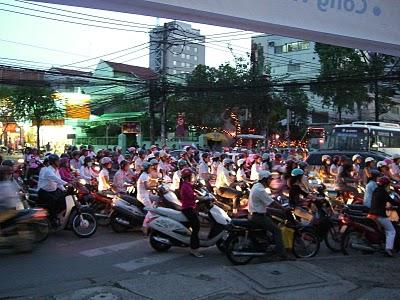 The infrastructure is still not sufficiently established. Traffic congestions are standard, the public transport system only consists of buses that get stuck in the congestions – but newly developed areas need to be accessible for commuters. To meet that problem a metro network is under construction and the bus fleet has been expanded.
The infrastructure is still not sufficiently established. Traffic congestions are standard, the public transport system only consists of buses that get stuck in the congestions – but newly developed areas need to be accessible for commuters. To meet that problem a metro network is under construction and the bus fleet has been expanded.
The heavy traffic (see picture) leads to serious air pollution which reduces the quality of life and makes a new traffic policy necessary. The bad air quality might lead to people leaving the central areas to new towns which, again, leads to a need of improved traffic infrastructure. A loss of inner city citizens might change the centre to a mere business district. Water pollution and increasing amounts of waste are other environmental problems that need to be met by the city’s government. Solving those problems might use a considerable percentage of Saigon’s gross earnings.
The country’s high inflation rate of about 8% over the last decade evens up the income improvements and might lead to investment shortages as well as rising rents what might have an inner city loss of inhabitants as a result.
Im Netz:
Stadtentwicklung in Ho Chi Minh Stadt: hier
Quellen (Auswahl):
Ho Chi Minh City, Vietnam’s thriving business centre, is definitely on a fast-forward mode. It developed from a small fishing village to a busy colonial trade spot to a not-to-be-ignored megacity packed with French colonial buildings right next to neck breaking sky scrapers. Especially since the economic opening of Doi moi the city is bursting with energy. Economic and city development is at speed and there is no end in view. Geozentrale’s first article in English tells the story of this city over the last 300 years with a focus on colonial and post-colonial times, and the ambitious projects the city is facing.
Pre-colonial time
 The first settlements in the area of today’s old town of Saigon date back to Khmer times from 1st to 6th century. It was rather a loose gathering of buildings than a town structured settlement. It was a fishing village as well as a trade centre with ties to China, India and Malaya which made foreign traders settle in the area. The port played an important role and is still the city’s nucleus.
The first settlements in the area of today’s old town of Saigon date back to Khmer times from 1st to 6th century. It was rather a loose gathering of buildings than a town structured settlement. It was a fishing village as well as a trade centre with ties to China, India and Malaya which made foreign traders settle in the area. The port played an important role and is still the city’s nucleus.In 1698 the area was captured by Viet people and mentioned in a document for the first time. Until colonial times a kind of threefold town developed: the port and administration town Saigon; Gia Dinh (Già Ðinh) as citadel and garrison town a few kilometres to the north-west of Saigon; and the Chinese trade spot Cholon (Chợ Lơn – Big Market) to the south-west (confer map left). The Chinese people of Cholon maintained strong trade relations to their mother country and used Saigon’s port as a basis. Additionally they were able to use its well developed administration structures. Saigon, however, could benefit from the Chinese’s trade ties which lead to a symbiotic relationship between both towns.
French colonial time (1864 – 1940)
Despite the early settling of the area there are hardly any buildings from pre-colonial times since the settlement that had existed until the arrival of the French stayed rather small and consisted merely of a couple of wooden huts at the western banks of the Saigon River. That changed enormously after 1861 when the French captured Saigon. This should be seen in the context of the colonial race with England, which had already seized two towns in the region, Singapore and Hong Kong. Shortly after the capture of Saigon the French started to transform the town into the administrative centre of Cochin China (the southern part of Vietnam). The development followed the building plans of 1862 and 1865 that intended to expand the town to 2,500 hectares and raise the number of inhabitants to 500,000. At that time there were only 50,000 Vietnamese and Chinese living in the area, plus about 600 Europeans.
 The development of Saigon is very similar to most south-east Asian commercial centres that have been expanded in colonial times, are mostly sea ports and arouse from trade functions. Thus the town was drawn up in a regular rectangular grid-like pattern with city blocks modelled on Paris; boulevards and avenues as main axis running from north-west to south-west respectively at right angles. The port depicted the core of the grid (confer map left). With this alignment the region’s main wind directions were acknowledged venting the town automatically. In addition the reference to Cholon and the port were established. Rue Catinat, today’s Ðường Ðóng Khởi, being the main axis from the port to the cathedral was designed as the main shopping street. Prestigious buildings such as the opera, Notre Dame Cathedral and the town hall erected in or close to Rue Catinat. Along with the Botanical Gardens they were all build until the end of the 19th century under French colonial reign.
The development of Saigon is very similar to most south-east Asian commercial centres that have been expanded in colonial times, are mostly sea ports and arouse from trade functions. Thus the town was drawn up in a regular rectangular grid-like pattern with city blocks modelled on Paris; boulevards and avenues as main axis running from north-west to south-west respectively at right angles. The port depicted the core of the grid (confer map left). With this alignment the region’s main wind directions were acknowledged venting the town automatically. In addition the reference to Cholon and the port were established. Rue Catinat, today’s Ðường Ðóng Khởi, being the main axis from the port to the cathedral was designed as the main shopping street. Prestigious buildings such as the opera, Notre Dame Cathedral and the town hall erected in or close to Rue Catinat. Along with the Botanical Gardens they were all build until the end of the 19th century under French colonial reign.The urban planning model of the French was the idea of a “Ville Parc”, which more than 20,000 trees were planted for (confer picture below). Due to its beauty Saigon was often referred to as “Perle de l’Extrême Orient”, it had developed from small market town to the thriving colonial metropolis of Indochina. The French colonial administration also built up a transport infrastructure in the form of tramways and railways. The train link from Saigon’s centre to Cholon does not exist anymore, neither does the French built main station; it was shifted
 further north and replaced by a park. The road layout in District 1 however has not changed since then and still meets the original sketches from the colonial time.
further north and replaced by a park. The road layout in District 1 however has not changed since then and still meets the original sketches from the colonial time.The picture shows the large amount of trees, the city blocks and grid-like pattern with wide tree-lined avenues. Notre Dame Cathedral is on the upper left rim with Rue Catinat leading towards it from the river.
After 1940
During World War II many people fled from the surrounding villages into the supposedly safer city which made the already existing housing shortage even worse. After the end of the war the biggest part of the infrastructure was destroyed. Many people returned to their villages and Saigon’s population decreased but the housing shortage persisted. Until 1965 the municipal area was filled up, especially between Saigon and Cholon and the main roads running from east to west; consistently both towns were united in 1956 and henceforth called Saigon-Cholon. During that period of US-American control there were no town planning initiatives but the Americans invested in administration, schools and universities, which led to a population increase; until 1967 it rose to 1.75 million. One of the few buildings erected in that period is the Reunification Palace (below) that
 substituted the French-built Presidential Palace. During the civil war Saigon, again, was a place of refuge for many rural dwellers and grew radial along the arterial roads, mostly to the north for rivers formed natural barriers to the east and south. Additionally the city’s centre got even more filled up. Due to a lack of housing squatter settlements emerged. On April 30th 1975, the day of “the fall” respectively “the liberation” of Saigon the population amounted to 2.5 million.
substituted the French-built Presidential Palace. During the civil war Saigon, again, was a place of refuge for many rural dwellers and grew radial along the arterial roads, mostly to the north for rivers formed natural barriers to the east and south. Additionally the city’s centre got even more filled up. Due to a lack of housing squatter settlements emerged. On April 30th 1975, the day of “the fall” respectively “the liberation” of Saigon the population amounted to 2.5 million.1975 – 1986
What followed was a process of de-urbanisation for the communist regime had decided to shrink large urban centres. It was necessary to obtain permits for housing and many dwellers were dislocated, refugees were to return to their places of origin, the urban growth slowed down and more or less stopped. From 1976 to 1980 400,000 people were to leave the city. That stark loss of population was partly compensated by the incorporation of Gia Dinh, but from 1979 to 1989 the annual population growth amounted to mere 0.3%. In 1976 Saigon was officially renamed Ho Chi Minh City which is often seen as a humiliation: the communists in power in the capital Hanoi considered Saigon as the “whore of America” and by far too liberal and capitalistic. The town, having always been the commercial centre of the country, was taken its industry, its population and all investments, in what section so ever, additionally all town planning measures were cancelled.
Economic opening “Doi moi” since 1986
 It wasn’t until “Doi moi” (Đổi mới) that this situation changed. A new housing policy was started and the secondary centres were upgraded which led to a strong influx to those. Since then the population grows steadily, especially due to stark rural-urban moves; from 1989 to 1999 by 2.7% annually, in 2007 by even 3.5%. At present the city’s development follows the model of a decentralised concentration which includes the satellite towns of Bien Hoa and Dau Mot, some 50 km away, infrastructure projects concerning several communes, new industry and high tech parks such as thriving Quang Trung Software City, the upgrade of the airport to an international hub and new town development projects in urban and suburban areas, such as Saigon South, which is supposed to provide housing and business space for 1 million people.
It wasn’t until “Doi moi” (Đổi mới) that this situation changed. A new housing policy was started and the secondary centres were upgraded which led to a strong influx to those. Since then the population grows steadily, especially due to stark rural-urban moves; from 1989 to 1999 by 2.7% annually, in 2007 by even 3.5%. At present the city’s development follows the model of a decentralised concentration which includes the satellite towns of Bien Hoa and Dau Mot, some 50 km away, infrastructure projects concerning several communes, new industry and high tech parks such as thriving Quang Trung Software City, the upgrade of the airport to an international hub and new town development projects in urban and suburban areas, such as Saigon South, which is supposed to provide housing and business space for 1 million people.The most ambitious development project might be a new district called Thu Thiem (Thủ Thiêm), a peninsula on the left bank of the Saigon River, right opposite of the old town (see map above). Saigon never emerged over to that part and thus the area offers wide more or less empty ground of 737 hectares. The city government plans to build it up as a “new urban area and the new and expanded center of Ho Chi Minh City with main functions of a financial, commercial, high-end services center of the city and region, having world class level; a cultural, recreation center, completing deficient or limited functions in existing city’s center.” The key concept envisages a connection to the river and the historic city centre, a dense and compact urban form with open space and the ability to grow. 110,000 to 120,000 people are expected to live there, it shall offer work for 350,000 employees and up to 1,000,000 visitors are expected each day.
It will be a skyscraper town many recent new towns are, yet it appears to be very green and airy. Infrastructure such as a railway and two metro lines, new bridges and tunnels connecting Thu Thiem and the city centre plus motorways is already under construction.
Completion is due in 2020. Whether the set targets will be achieved will have to be seen. Especially the connection to the old town seems difficult for the river is very wide and the old town works well without the expansion.
Problems
 The infrastructure is still not sufficiently established. Traffic congestions are standard, the public transport system only consists of buses that get stuck in the congestions – but newly developed areas need to be accessible for commuters. To meet that problem a metro network is under construction and the bus fleet has been expanded.
The infrastructure is still not sufficiently established. Traffic congestions are standard, the public transport system only consists of buses that get stuck in the congestions – but newly developed areas need to be accessible for commuters. To meet that problem a metro network is under construction and the bus fleet has been expanded.The heavy traffic (see picture) leads to serious air pollution which reduces the quality of life and makes a new traffic policy necessary. The bad air quality might lead to people leaving the central areas to new towns which, again, leads to a need of improved traffic infrastructure. A loss of inner city citizens might change the centre to a mere business district. Water pollution and increasing amounts of waste are other environmental problems that need to be met by the city’s government. Solving those problems might use a considerable percentage of Saigon’s gross earnings.
The country’s high inflation rate of about 8% over the last decade evens up the income improvements and might lead to investment shortages as well as rising rents what might have an inner city loss of inhabitants as a result.
Im Netz:
Stadtentwicklung in Ho Chi Minh Stadt: hier
Quellen (Auswahl):
Dovert, S./Ninh, L.Q. (1998): Architectures Urbanisme. Saigon.
Düttmann, M. (2001): Saigon, Vietnam. In: Stadtbauwelt, issue 36, volume 92.
Waibel, M. (2004): Sturm auf Vietnams Metropolen? Auswirkungen der Land-Stadt-Migration auf die Siedlungs- und Wohnstrukturen. In: Südostasien 3/05.
Wüst, S. (2001): Die Metropolisiserung von Ho Chi Minh Stadt. In: Stadtbauwelt, issue 36, volume 92.
Bilderquellen: http://belleindochine.free.fr/images/Plan, eigene Bilder

